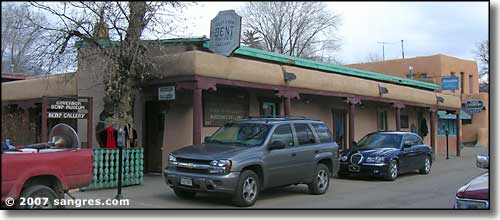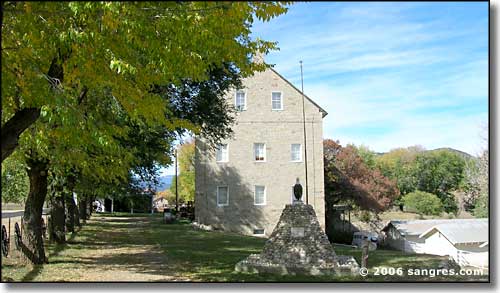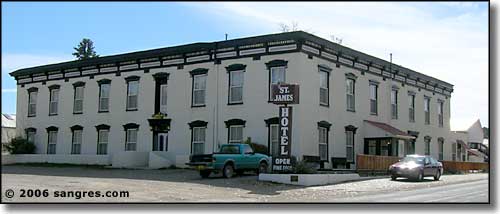 |
The Maxwell (Beaubien-Miranda) Land Grant
|
|
|
 The Governor Bent Home and Museum in Taos |
|
In 1841, Charles (Carlos) Beaubien, a Canadian-born citizen of Mexico who lived in Taos, applied to the governor in Santa Fe for a land grant. His partner in this venture was Guadalupe Miranda, the governor's secretary. The land they applied for was described only by the use of visual landmarks. Governor Manuel Armijo approved the grant application three days after it was submitted and before any effective opposition could be mustered. While the maximum land grant allowed under Mexican law was 92,000 acres, this Beaubien-Miranda Grant wasn't surveyed until 1877 when it measured some 1,714,764 acres. This particular fact was a continual problem, even after an act of Congress in 1860 declared the boundaries of the grant to be valid. Shortly after the grant was approved, Lucien Bonaparte Maxwell, an American frontiersman (of the Menard family of Illinois), settled in Taos and married Luz Beaubien, one of Charles' daughters. As a wedding gift, Charles gave Lucien 15,000 acres of the grant land. A good friend of Lucien's, Kit Carson, also settled in Taos and married Josefa Jaramillo, daughter of another prominent Taoseño family. In 1846 came the Mexican-American War and that next January brought the Taos Rebellion. In this rebellion several prominent American and Mexican members of the community were killed. One was Charles Bent, Territorial Governor of New Mexico. Another was Narciso Beaubien, Charles' son and heir. After this, Charles declared Lucien Maxwell to be his successor and heir and when Charles died in 1864, Lucien bought out all his father-in-law's other family members and partners. He became the sole owner of the largest privately-owned piece of land in America. Maxwell was known to be a generous man and a kind host. He established the towns of Rayado and Cimarron. He welcomed the wagon trains taking the Mountain Route of the Santa Fe Trail. He encouraged pioneers like John Dawson and Manley Chase to buy land at low prices and on generous terms (Dawson bought more than 24,000 acres for $3,700). His was a dream of managed and controlled growth. Then in 1866, gold was discovered on Baldy Mountain, northeast of today's Eagle Nest. In 1867, mining squatters founded Elizabethtown (to service the gold mines on Baldy Mountain) and within a year E-town had a population approaching 7,000. As he was not inclined to take action against the squatters, he developed his own mining operation on Baldy Mountain and established generous lease agreements with some of the new arrivals. However, quite a few of these squatters refused to settle with Maxwell and, instead, tried to get the politicians to intervene: specifically the Federal Surveyors Office and the Department of the Interior. |
 Grain Mill built in Cimarron by Ceran St. Vrain, 1867, now the Old Mill Museum |
|
In 1868, the newly-elected Vice President of the United States, Schuyler Colfax visited northern New Mexico and Colorado before taking office at the inauguration of U.S. Grant in 1869. To curry political favor, the citizens of Elizabethtown petitioned the Territorial Legislature of New Mexico to create Colfax County, in the Vice President's honor. This was approved in January, 1869, and encompassed all of the Maxwell Land Grant (except the 265,000 acres in Colorado) and included some other land bringing the county to the borders of Oklahoma and Texas. At the same time, the Territorial Legislature made Elizabethtown the first county seat, giving the squatters effective legal control over the grant. In 1870, Maxwell decided to sell the grant, keeping only his two-story mansion in Cimarron and the 1200 acres around it. He optioned the rest of the property to three Colorado businessmen who had strong political ties in Washington and in Europe. Within a year they had sold the grant to British investors who then sold it to a consortium of Dutch investors out of Amsterdam. Maxwell's share of the profits was $650,000, which he used to buy the abandoned Fort Sumner and Bosque Redondo property in eastern New Mexico. He lived there until he died in 1875. When the foreign investors bought the grant, they were told that the 1860 Act of Congress gave them clear and valid title to the property. What they really got was the controversy that became known as the Colfax County War. The Dutch investors formed the Maxwell Land Grant Company and began the task of sorting out who among the settlers had valid lease or sales agreements with Maxwell and who were squatters. Those identified as squatters at first got polite letters inviting them to settle up. They ignored. So the company turned the matter over to the Territorial Attorney General, Thomas Catron, to prepare eviction notices. This caused a problem because Catron was a friend and business associate of Stephen Elkins, president of the land company's board of directors. This also caused a riot in Elizabethtown a few months after the foreign investors took ownership of the grant, a riot so serious that Elkins petitioned the governor to send soldiers from Fort Union to restore order. In 1872, the county seat, with all its' judicial and record-keeping privileges, was moved to Cimarron, also where the headquarters office of the land grant company was. Then more eviction notices were served. They were again ignored. At this point the land grant company elected as vice president and COO the chief construction engineer of the Santa Fe Railroad, one William Raymond Morley. Morley was aware that the grant company controlled the key right-of-way over Raton Pass and he took a leave of absence from the railroad to try to strengthen the relationship between the land grant and the railroad. Aware of the impasse between the land grant company and the squatters, Morley requested his friend, Frank Springer, of his native Iowa, to come and help sort out the problem. Springer was a brilliant, analytical and honest attorney. He became one of the most respected of the territorial pioneers. He and his brother Charles founded the CS Ranch, which is still owned and operated by their descendants. In 1874, ignoring the 1860 Act of Congress, the Federal Department of the Interior declared the land grant to be public domain. At about the same time, the Maxwell Land Grant Company defaulted on their property tax obligations. A public auction was held and Melvin Mills, an associate of Thomas Catron, bought the property for $16,479 in back taxes, intending to sell it to Catron for $20,000. When this plan was exposed, the Dutch owners raised enough money to redeem the property. And exposure of this plan shed light on the “Santa Fe Ring,” a secret Republican coalition designed to control public offices in New Mexico, especially the judiciary. Widely suspected as members of the Ring were Stephen Elkins, Dr. Robert Longwill, Melvin Mills and Thomas Catron (who, by then, was no longer the Territorial Attorney General). When they became aware of possible hidden motives, Morley and Springer founded The Cimarron News and Press, a newspaper which regularly criticized the Santa Fe Ring. This got both men marked for assassination. In July, 1875, a letter appeared in the New York Sun exposing the Santa Fe Ring and naming Stephen Elkins, Thomas Catron and local judge Joseph Palen as key members. In September of that year, Methodist minister Franklin J. Tolby of Cimarron, an outspoken anti-grant activist who had publicly criticized Judge Palen and the grand jury for not indicting local gunman Pancho Griego for killing two soldiers in a gambling quarrel, was found dead near the Palisades in Cimarron Canyon. He had been shot twice in the back, all of his belongings were intact and his horse was neatly tethered to a nearby tree. Tolby was returning to Cimarron on September 14 after administering to his flock in the Moreno Valley but his body was not found for two days. Between the time of the murder and the discovery of the body a mail delivery had gone through the canyon and supposedly did not see Tolby's horse in plain sight of the main trail nor his body lying nearby. Tolby's part-time assistant, the Rev. Oscar P. McMains, was outraged. He fanned the flames of vigilante justice and he and his newly formed vigilante group confronted the mail contractor, Florencio Donoghue (who was also tied to the Santa Fe Ring). The frightened Donoghue told them he had hired Cruz Vega to do the mail delivery that one day and that Vega was staying at a ranch in the Moreno Valley. The then-hooded vigilantes rode the 30 miles over to the valley and hunted down Vega. They tied him to a tree in a hanging position and tortured him until he confessed. He shouted his innocence but also implicated Manuel Cardenas, who he said was hired by Donoghue to kill Tolby and who did the actual killing. The mob exploded and hung Vega on the spot. Cardenas was arrested by the legal authorities and he insisted that Vega had done the killing. At the same time he identified Dr. Robert Longwill and Melvin Mills as members of the Santa Fe Ring. Cardenas changed his story several times but as he was being led from the courtroom to the jailhouse he was shot and killed in the dark by an unknown assassin. Melvin Mills was in Colorado on business at the time but when he heard about the accusations, he voluntarily returned to Cimarron to face the music. He was threatened many times but staunchly requested a court hearing. Frank Springer, widely known as no friend of the Ring, defended him and the charges were dismissed for lack of evidence. Robert Longwill, on the other hand, ran from town on horseback pursued by a posse led by Clay Allison. Longwill made it to his home where he told his wife to tell anyone following him that he was suffering from cholera. Then he changed horses and high-tailed it for Santa Fe. He was never heard from again. |
 The St. James Hotel in Cimarron, NM |
|
Three days after the Vega hanging, Pancho Griego stalked Clay Allison in hopes of avenging his friend's killing (Griego maintained that the outspoken Allison was one of the hooded vigilantes). They met at the St. James Hotel in Cimarron. Hoping to cool things down, owner Henry Lambert poured each of them a drink. Griego took off his hat and pretended to fan himself while reaching for his gun. Allison spotted the ruse and shot and killed him. In court the killing of Griego was ruled self-defense. Rev. McMains was arrested and charged with inciting to riot. Defended by Frank Springer, the jury convicted McMains of “a felony in the fifth degree” and fined him $300, tantamount to an acquittal. Four months after Tolby's murder, Governor Samuel Axtell signed a legislative bill transferring all of Colfax County's judicial powers to Taos County. Hoping to convince Axtell that conditions had settled down and judicial power should be returned to Colfax County, Springer, Morley, Allison, and Cimarron business leader Henry Porter invited the governor to come to Cimarron so they could present their case. Problem was, Axtell was considered by many to be a tool of the Santa Fe Ring. What happened next was more incredible than any fiction. In March, 1876, Benjamin Stevens, District Attorney for the 2nd Judicial District at Las Vegas, met with Morley and told him the governor would come to Cimarron on a specific day on one condition: this was to be a private meeting with no public announcement and no crowd present. Stevens then went to Fort Union and returned to Cimarron with a company of Buffalo Soldiers of the Ninth Regiment (This was premeditated: Allison was formerly a Confederate soldier, a known Yankee hater with an animosity toward blacks. It was hoped that he'd get confrontational and provide an easy excuse for his own murder). The committee of four were then told the governor would arrive in Cimarron by coach the following Saturday. Axtell had no intention of coming. He wrote a letter to Stevens, advising him, "Do not hesitate at extreme measures. Your honor is at stake now and a failure is fatal." The letter was put into a trunk marked for Stevens which was then sent by stagecoach to Cimarron. The trunk was stolen, the letter inside given to Frank Springer and he informed the others of the plot. The next day he wrote to the governor of the letter and the governor replied that the letter must have been a forgery, written as it was in pencil on plain paper with no letterhead. The captain of the Buffalo Soldier company later confirmed the details of the assassination plot against the four men and identified Clay Allison as the main target. In 1878, President Rutherford B. Hayes removed Axtell from office and replaced him with Lew Wallace, a Civil War hero who later wrote Ben Hur. In 1878, Frank Morley resigned his office with what was now the Maxwell Land Grant and Railway Company and returned to his position with the Santa Fe Railroad. Clay Allison eventually settled with the land grant company and then sold his ranch and moved to Pecos, Texas. Frank Springer became a world-famous paleontologist and achieved even greater respect in Colfax County as a lawyer and rancher. In 1877, the Maxwell Land Grant and Railway Company had commissioned Stephen Elkins' brother John to do a survey of the property. Because of this relationship, John's survey, although competent, was called into question. In 1882, the federal government filed a bill in US District Court in Colorado alleging the grant "to be falsely, fraudulently and deceitfully surveyed." At main issue was the 265,000 acres of the grant in Colorado. Frank Springer defended the grant's interests. He called men such as Calvin Jones and Uncle Dick Wootton as witnesses: these men being familiar with the grant's original boundaries back to the days of Mexican rule. Elkins' survey books were carefully examined and found to be essentially accurate. The government's case collapsed and the District Court ruled in favor of the Maxwell Land Grant and Railway Company. Federal officials then appealed to the US Supreme Court, who gave the case a high priority but didn't actually hear the case until 1887. In 1885 the grant company was conducting an aggressive campaign to remove any settlers who were not sanctioned by the company. They hired 35 enforcers led by Bat Masterson's brother James and got the governor to give them militia status, a stamp of official approval. A group of Raton citizens went to Santa Fe and convinced the governor that Masterson's so-called militia was composed of “gunmen, killers, thugs and bums from outside New Mexico.” After losing their official sanction, Masterson's men were not about to disband and James himself answered the committee by pistol-whipping one of its' members from Raton and throwing his unconscious body in the gutter. When this happened, 600 citizens gathered at the Raton Rink and, led by George Curry (later to become Territorial Governor of New Mexico), determined a course of action. First thing, they bought up all the guns and ammunition available in Raton. While 150 men patrolled the streets in Raton, Masterson and his men were rounded up, taken to the Colorado border and told to never come back to New Mexico. They meekly left. On March 8, 1887, Frank Springer, representing the Maxwell Land Grant and Railway Company, began four days of oral argument and 900 pages of testimony in front of the US Supreme Court. Five weeks later in its' ruling, the Court concluded “We are entirely satisfied that the Grant, as confirmed by the action of Congress, is a valid grant, that the survey and the patent issued upon it are entirely free from any fraud.” The anti-grant forces lost and either settled up with the company or moved elsewhere. Hispanic families who had settled in the Rayado area generations before were finally evicted in 1894. Richard Russell was defending what he thought was his homestead rights when he was killed in a shoot-out with company enforcers near his ranch in Stonewall, Colorado in 1888. His wife, famous pioneer Marian Sloan Russell, carried on the fight, producing homestead papers in court but she eventually lost the case and had to settle. By this time Elizabethtown was still producing some gold but was no longer a big, bustling boom town. Coal was discovered on John Dawson's ranch in 1895 but the Dawson Fuel Company didn't open its first mine until 1901 when a railroad spur was built from Tucumcari to Dawson. This was the beginning of a whole new era on the Maxwell Land Grant. |
|
|
 |
| Index - Arizona - Colorado - Idaho - Montana - Nevada - New Mexico - Utah - Wyoming National Forests - National Parks - Scenic Byways - Ski & Snowboard Areas - BLM Sites Wilderness Areas - National Wildlife Refuges - National Trails - Rural Life Sponsor Sangres.com - About Sangres.com - Privacy Policy - Accessibility |
| Most of this information was gleaned by and from Jack Urban of Angel Fire, NM. Highly recommended reading: Lure, Lore and Legends of the Moreno Valley Photos courtesy of Sangres.com, CCA ShareAlike 3.0 License. Text Copyright © by Sangres.com. All rights reserved. |